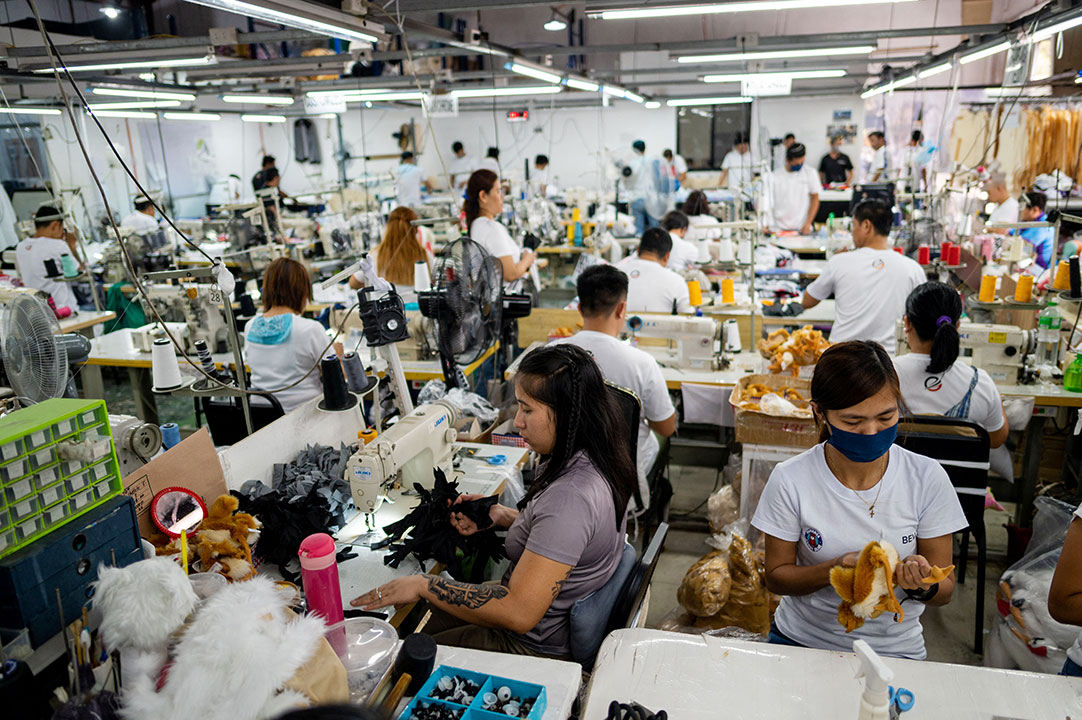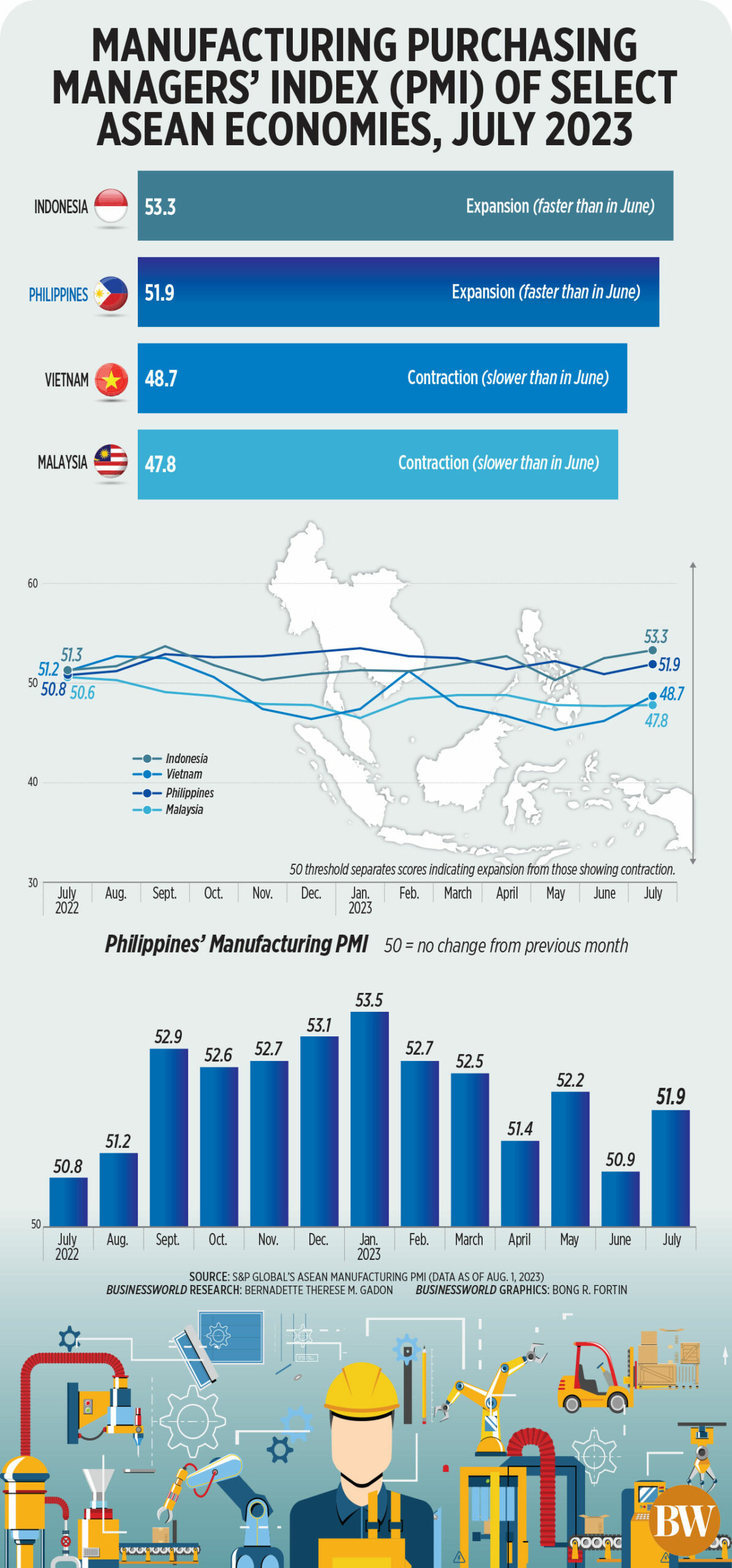




Policy Rate Updates: Double cut finale
 DOWNLOAD
DOWNLOAD

Monthly Economic Update: One for the road
 DOWNLOAD
DOWNLOAD

Inflation Update: Still low, still slow
 DOWNLOAD
DOWNLOAD


PH factory activity perks up in July

Manufacturing activity in the Philippines improved in July due to the growth in output and new orders, S&P Global said.
The S&P Global Philippines Manufacturing Purchasing Managers’ Index (PMI) rose to 51.9 in July from the 11-month low of 50.9 in June.
“The latest PMI reading for the Filipino manufacturing sector signaled a stronger improvement in operating conditions at the start of the third quarter,” Maryam Baluch, economist at S&P Global Market Intelligence, said in a statement.
 July also marked the 18th straight month that the PMI reading was above 50.
July also marked the 18th straight month that the PMI reading was above 50.
A PMI reading above the 50 mark which denotes improvement in operating conditions, while a reading below 50 signals deterioration.
The headline PMI measures manufacturing conditions through the weighted average of five indices: new orders (30%), output (25%), employment (20%), suppliers’ delivery times (15%), and stocks of purchases (10%).
Based on the latest available data, the Philippines had the second-highest PMI reading out of four Southeast Asian countries, just behind Indonesia (53.3). Vietnam (48.7) and Malaysia (47.8) both reported a contraction in factory activity.
“Continued improvement in the underlying demand picture helped drive the latest upturn, with both production and new orders recording stronger rates of expansion. New export orders also increased during July,” Ms. Baluch said.
Output growth accelerated in July after hitting a 10-month low in the previous month, S&P Global said. “Moreover, the respective seasonally adjusted index signaled a modest expansion in production volumes overall.”
New orders also registered a quicker expansion during the month.
“Anecdotal evidence noted that a growing customer base and improved underlying demand trends propelled the latest upturn. At the same time, foreign demand for Filipino goods grew for the seventh successive month. The rate of growth in new export orders accelerated to a three-month high,” S&P Global added.
The survey also showed that the pace of purchasing activity was the fastest since January.
“Greater production requirements and a faster rise in new orders fed into a sharper expansion in purchasing activity during July,” it said.
S&P Global said export sales went up at a quicker clip, fueled by an increase in foreign clients. “As a result, companies further raised their buying activity in line with greater production requirements,” it added.
The survey also showed capacity pressures eased in July as the overall volume of work-in-hand dropped for the first time in five months.
This allowed Philippine manufacturers to cut jobs for the second straight month.
Vendor performance also worsened during the month. Ms. Baluch said that if this continues to deteriorate, it may pose a headwind for the manufacturing sector.
“After shortening for the first time in nearly four years during May, average lead times have been extended for two consecutive months. Moreover, the rate at which delivery times worsened was the most pronounced since December 2022,” S&P Global said.
Inflationary pressures also picked up slightly in July.
“Moreover, though July data reported a slight intensification of price pressures, rates of both input price and output charge inflation have eased considerably from the highs seen over the last three years,” Ms. Baluch said.
S&P Global noted almost half of Philippine manufacturing firms expect growth in production in the next 12 months.
“Though business expectations regarding future output eased from June’s five-month high, they remained optimistic in July,” it added.
Rizal Commercial Banking Corp. Chief Economist Michael L. Ricafort said the improved manufacturing conditions last month can be attributed to the continued downtrend in inflation.
“Other positive factors that kept the local manufacturing PMI better than other countries at expansion mode or above 50 despite some slowdown in recent months may partly have to do with the recent easing trend in prices,” he said in a Viber message.
Headline inflation likely settled within the 4.1-4.9% range in July, according to the Bangko Sentral ng Pilipinas’ (BSP) latest forecast.
If realized, July would be the first time that inflation would fall below the 5% mark since April 2022.
The central bank expects inflation to average 5.4% this year, still above its 2-4% target.
“President Ferdinand R. Marcos, Jr. lifted the COVID-19 state of public health emergency throughout the country on July 22, thereby could lead to more business and economic activities, as well as faster expansion in manufacturing,” Mr. Ricafort added.
ING Bank N.V. Manila Senior Economist Nicholas Antonio T. Mapa said that the latest PMI reading signals further improvement in the coming months.
“This is a welcome development given the current dour outlook on global trade and could give hope for a recovery down the road,” he said in a Viber message.
“Meanwhile, the reduction in payrolls numbers was a bit disappointing but given that a portion of the decline was tagged to resignation could signal workers shift to more lucrative opportunities,” he added. — Luisa Maria Jacinta C. Jocson, Reporter
This article originally appeared on bworldonline.com





 By BusinessWorld
By BusinessWorld